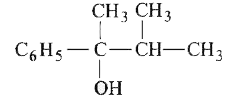Give chemical equations for the synthesis of the following compounds, starting with cyclopentane, C5H10, alcohols of three or fewer C's, HCHO and inorganic reagents.
Cyclopentanecarbaldehyde
To synthesize cyclopentanecarbaldehyde starting from cyclopentane (C₅H₁₀), we can follow these steps:
Step 1: Chlorination of Cyclopentane
First, we need to convert cyclopentane into a cyclic alkyl halide. This can be achieved through chlorination in the presence of light.
Chemical Equation:
C5H10+Cl2hv−→C5H9Cl+HCl
Step 2: Formation of Grignard Reagent
Next, we will react the alkyl halide (C₅H₉Cl) with magnesium (Mg) in dry ether to form a Grignard reagent.
Chemical Equation:
C5H9Cl+Mgether−−−→C5H9MgCl
Step 3: Reaction with Formaldehyde
Now, we will react the Grignard reagent with formaldehyde (HCHO). The Grignard reagent acts as a nucleophile and attacks the carbonyl carbon of formaldehyde.
Chemical Equation:
C5H9MgCl+HCHO→C5H10(OH)MgCl
Step 4: Protonation
The resulting alkoxide (C₅H₉(OH)MgCl) will be protonated to form a secondary alcohol.
Chemical Equation:
C5H10(OH)MgCl+H2O→C5H10OH+MgClOH
Step 5: Oxidation to Aldehyde
Finally, we will oxidize the alcohol (C₅H₉OH) to obtain cyclopentanecarbaldehyde using an oxidizing agent like chromium trioxide (CrO₃).
Chemical Equation:
C5H10OH+CrO3→C5H9CHO+H2O
Final Product
The final product obtained is cyclopentanecarbaldehyde (C₅H₉CHO).
---
First, we need to convert cyclopentane into a cyclic alkyl halide. This can be achieved through chlorination in the presence of light.
C5H10+Cl2hv−→C5H9Cl+HCl
Next, we will react the alkyl halide (C₅H₉Cl) with magnesium (Mg) in dry ether to form a Grignard reagent.
C5H9Cl+Mgether−−−→C5H9MgCl
Now, we will react the Grignard reagent with formaldehyde (HCHO). The Grignard reagent acts as a nucleophile and attacks the carbonyl carbon of formaldehyde.
C5H9MgCl+HCHO→C5H10(OH)MgCl
The resulting alkoxide (C₅H₉(OH)MgCl) will be protonated to form a secondary alcohol.
C5H10(OH)MgCl+H2O→C5H10OH+MgClOH
Finally, we will oxidize the alcohol (C₅H₉OH) to obtain cyclopentanecarbaldehyde using an oxidizing agent like chromium trioxide (CrO₃).
C5H10OH+CrO3→C5H9CHO+H2O
The final product obtained is cyclopentanecarbaldehyde (C₅H₉CHO).
Topper's Solved these Questions
- ALDEHYDES, KETONES AND CARBOXYLIC ACIDSBook:ICSEChapter:ALDEHYDES, KETONES AND CARBOXYLIC ACIDSExercise:EXERCISE (PART-I OBJECTIVE QUESTIONS)
Explore 303 Videos
- ALDEHYDES, KETONES AND CARBOXYLIC ACIDSBook:ICSEChapter:ALDEHYDES, KETONES AND CARBOXYLIC ACIDSExercise:EXERCISE (PART-II DESCRIPTIVE QUESTIONS) (VERY SHORT QUESTIONS)
Explore 282 Videos
- ALCOHOLS, PHENOLS AND ETHERS Book:ICSEChapter:ALCOHOLS, PHENOLS AND ETHERS Exercise:ISC EXAMINATION QUESTIONS
Explore 25 Videos
- APPENDIX II ( TYPICAL CONVERSIONS)Book:ICSEChapter:APPENDIX II ( TYPICAL CONVERSIONS)Exercise:AROMATIC CONVERSIONS
Explore 98 Videos
Similar Questions
Give chemical equations for the synthesis of the following compounds, starting with cyclopentane, C5H10, alcohols of three or fewer C's, HCHO and inorganic reagents.
Pentaoe-1,5-diol
View SolutionGive chemical equations for the synthesis of the following compounds, starting with cyclopentane, C5H10, alcohols of three or fewer C's, HCHO and inorganic reagents.
Pentaoe-1,5-diol
View Solution
Knowledge Check
Which set of the following reagents would you select to convert C6H5COCH3 (acetophenone) to the following alcohol ?
 ACH3CH2CH2MgBr and hydrolysisBCH3CH(Br)CH3⋅AlCl3C(CH3)2CHMgBr and acid hydrolysisDCH3CHCHCH3,Zn
ACH3CH2CH2MgBr and hydrolysisBCH3CH(Br)CH3⋅AlCl3C(CH3)2CHMgBr and acid hydrolysisDCH3CHCHCH3,Zn
Give chemical equations for the synthesis of the following compounds, starting with cyclopentane, C5H10, alcohols of three or fewer C's, HCHO and inorganic reagents.
Pentane-1,5-diol
View SolutionGive balanced chemical equation for the preparation of the following organic compounds.
A unsaturated hydrocarbon from an alcohol.
View SolutionCalculate the DU of following compounds :
(i) C6H6ClBrO , (ii) C5H9N
View SolutionGive the common names of the following alcohols :
(C2H5)3COH
View Solution(a) Name the reagents and write the chemical equations for the preparation of the following compounds by Williamson's synthesis :
(i) Ethoxybenzene
(ii) 2-Methyl-2-methoxpyropane
(b)Why do phenols not give the protonation reaction readily?
View SolutionGive the reaction of the following :
i.
ii. 2−Bromo butane +C2H5Ona( three products )
View SolutionGive the IUPAC name of the following compound:
C6H5−CH2−CH2−OH
View Solution